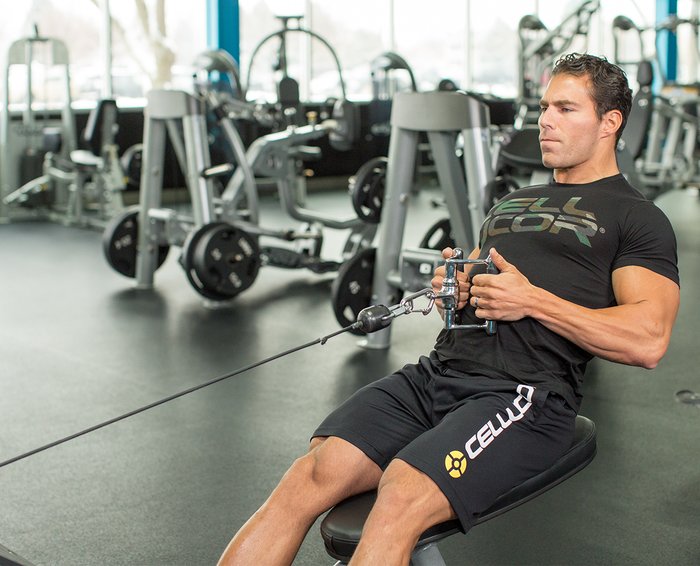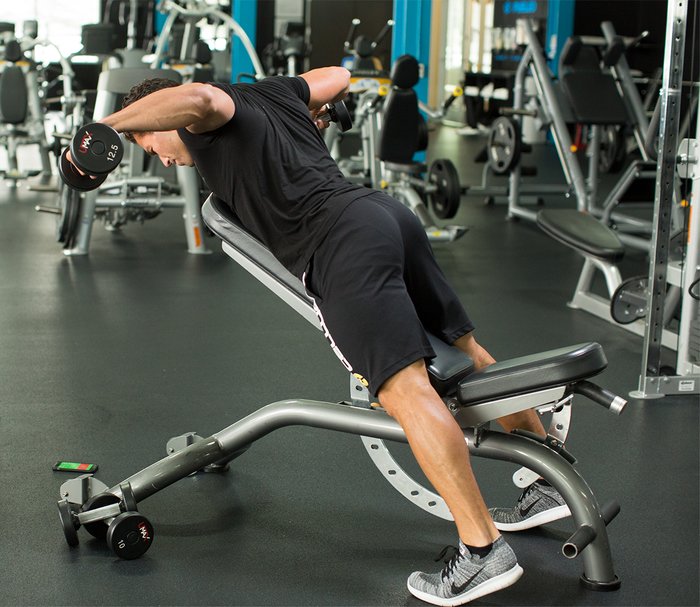How much thought have you given to your next back workout? Maybe you've got your standard routine all worked out: A handful of exercises; 3 sets of 10 reps; train hard; work for a muscle pump. Your back workout might as well be etched on a stone tablet.
For Cellucor-sponsored IFBB physique pro Craig Capurso, however, back day looks a lot different.
Capurso likes to say that he doesn't follow a routine: He follows a plan. No room for error, nothing left to chance. Progression of multijoint back exercises? Check. Varied rep targets to achieve multiple aims? Got it. Attack the lats from multiple angles? Yep. Finishing techniques that flood the muscles with blood, as if to force surrender? It's all in the plan, man.
"In one single workout, we're going to improve power, strength, muscle size, and muscle endurance," Capurso says. "My plan includes lots of different ways to train the back musculature, so it really is the ultimate back workout—and it gets you out of the gym in less than an hour."

Follow These Rules!
- Warm up, then start with the most challenging exercises. Progressing to slightly less complex ones as you get tired.
- Start each workout with heavier loads and lower reps for a greater strength emphasis. Increase reps and decrease loads as you progress through the session.
- Match your rest times with the most difficult exercises and heaviest loads. As you reduce loads and reps, reduce your rest periods.
- Hit all the backside musculature—the lats, rhomboids, upper and lower traps, teres major, and even the rear delts (involved in rowing motions). Finish off the back-day posteriors with a single-joint movement, a common tactic among experienced bodybuilders.
- Finish off the workout with single-joint movements done Tabata-style to create an intense pump in the target muscles.



BodyFit
$6.99/month- 2,500+ expert-created single workouts
- 3,500+ how-to exercise videos
- Detailed workout instruction
- Step-by-step workout tips
- Training at gym or at home
- Access to Workout Plans
- Access to Bodyfit App
- Store Discounts
Already have a Bodybuilding.com account with BodyFit? Sign In

What comes with BodyFit?

- Instructional Videos
Don't risk doing a workout improperly! Avoid injury and keep your form in check with in-depth instructional videos.

- How-to Images
View our enormous library of workout photos and see exactly how each exercise should be done before you give it a shot.

- Step-by-Step Instructions
Quickly read through our step-by-step directions to ensure you're doing each workout correctly the first time, every time.
Workout Tips
1. Warm up with an exaggerated, Tabata-style lat movement
Capurso's warm-up includes both cardio and Tabata-style exercise. Get your heart rate up and your blood pumping with the seated cable row. Choose your 20RM load, but instead of working for reps, work for time. Alternate eight 20-second work segments with 10-second rest periods. Continue for 4 minutes.
Use a slightly exaggerated range of motion for a more complete warm-up, going just a bit further than the normal range-of-motion endpoints. Maintain proper back alignment to protect your spine.
2. Start with a heavy 5x5 approach on the barbell deadlift
Heavy deadlifts are the cornerstone of many challenging back workouts. Between the amount of muscle mass involved and the low rep target, deadlifts can provoke a powerful anabolic stimulus.
Capurso's plan gives you more of a strength stimulus up front by using a heavier load on barbell deadlifts and pulling the rep target down to 5. This creates "5X5s"—5 sets of 5 reps each.

"5x5s deliver a stronger strength stimulus than a lighter load would, and set the foundation for the volume to come" says Capurso. "Choose a weight you can do about 6 reps with—in good form and with max effort. Stop your first 2 sets short of muscle failure, with your last three sets coming very close to failure."
If you start to lose form during the movement, stop. You're done.
3. Accentuate the negative with a moderate rep target on pull-downs
Next up, neutral-grip pull-downs. Capurso adds volume and accentuates the eccentric portion of the rep by taking about 8 seconds to return his hands to the starting position. Research suggests that this technique, known as negative-rep training, causes you to produce 20-60 percent more force on the way up than on the way down.
Use a wide, neutral grip for the pull-downs. Keep your elbows out away from your body so you can emphasize the middle and lower traps, rhomboids, upper lats, and rear delts. Capurso suggests using wrist straps if you have trouble holding on to the bar for longer sets.

4. Add volume with T-bar rows, pushing higher rep targets
Capurso creates a higher rep target with another multijoint exercise, the T-bar row. At this point in the workout, chances are you'll be smoked. To get through the T-bar row, you're going to have to dig deep to get through the lower-load/higher-rep-target approach with 3 sets of 15 reps to develop both muscle strength and muscle endurance.
5. Target the rear delts with a Tabata finisher
Not everyone trains rear delts with back. Then again, in this case, you're working these muscles already. Why not just finish them off?
Capurso's choice of a seated single-joint exercise helps you to really isolate the rear delts, which will explode under the Tabata protocol. Alternate 20-second work segments with 10 seconds of rest for eight segments, which should take about 4 minutes.
Use a weight you can do for about 20 reps (your 20RM) before reaching muscle failure. But do this exercise for time, not reps.

6. Finish with a single-joint lower-lat exercise, also done Tabata-style
Moving back to the lats, Capurso applies the same finishing technique to the standing straight-arm lat pull-down. "It's a perfect finisher, because your muscles are already pumped," he says. "The pump will be more pronounced than anything you've ever done before. It'll squeeze out every last bit of energy they have left until your lats are on fire." Once again, use your 20RM load.
Putting It All Together
As you move through this kick-ass workout, take notes, so you know where to start next time—and what to aim for in the future. As with other workouts, push yourself to increase your loads and/or reps over time. After about six weeks—once your body has adapted to a new training stimulus—make further changes in your back training to keep it challenging.
Throughout this program, pay close attention to post-workout nutrition and recovery. Next-day muscle soreness can be especially noticeable after the first one or two workouts, but should ease up after that.
If you like this workout, check out Capurso's Ultimate Arms workout, too!


